Analyzing Leadership's Role in Organizational Change at AFFCO Holdings
VerifiedAdded on 2020/04/21
|11
|2006
|81
Report
AI Summary
This report examines the critical role of leadership in driving organizational change, using AFFCO Holdings, a New Zealand-based consumer goods manufacturer, as a case study. The analysis explores how leadership influences strategic decisions and adapts to market demands. The report delves into the application of leadership models such as the McKinsey 7S model, vMEME model, and Force Field Analysis to understand how AFFCO Holdings manages its resources, maintains stakeholder relationships, and enhances its competitive advantage. The study highlights the importance of communication, skilled workforce management, and strategic planning in achieving sustainable organizational growth. The report concludes that effective leadership is essential for navigating internal and external changes, ensuring the organization's long-term objectives are met, and adapting to the ever-evolving business environment.
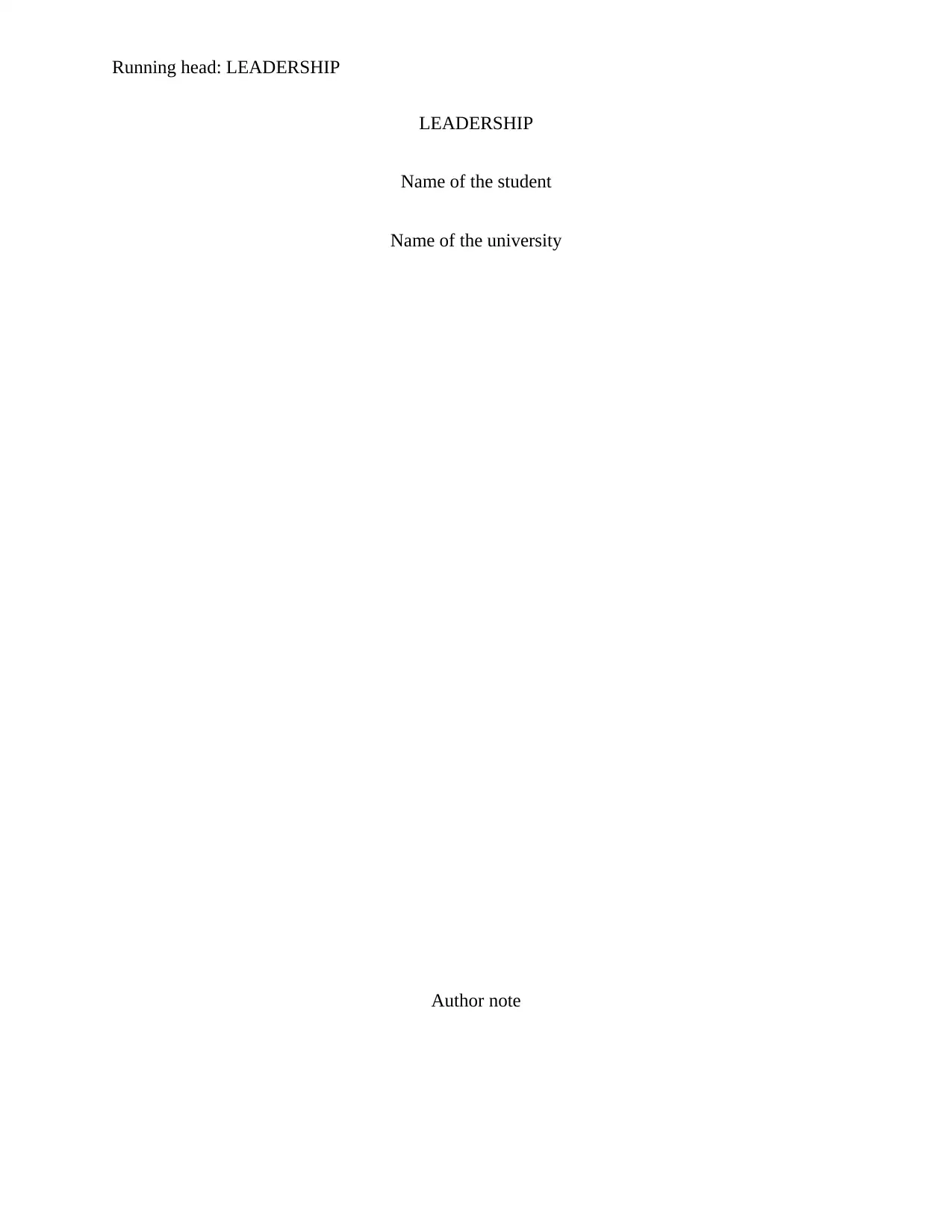
Running head: LEADERSHIP
LEADERSHIP
Name of the student
Name of the university
Author note
LEADERSHIP
Name of the student
Name of the university
Author note
Paraphrase This Document
Need a fresh take? Get an instant paraphrase of this document with our AI Paraphraser

1LEADERSHIP
A leader is a person who brings about the organizational change and helps the
organization in identifying the long term objectives. It helps the organization in making careful
decisions based on the organizational growth and sustainability. The movement of the
organizations based on the requirements of the consumers is being facilitated by the effective
functioning and decision making of the leader.
The autocratic leadership helps in determining the changes that are being undertaken by
the organizations. The most important phenomenon of the change is based on the requirements
of the people. The concerned company for this discussion, AFFCO Holdings, which is a New
Zealand based organization, manufactures consumer goods. To be more specific the company
processes meat and supplies their stock based on the requirements of the people. The form of
leadership undertaken by the company is based on their structure and the functions undertaken
by the organization.
The discussion is aimed at understanding the importance of leadership relating to the
changes that are being required to be undertaken by the organization in order to ensure the
improvements and thereby promote the sustainability of the organization (Avolio & Yammarino,
2013). The discussion will hold views of the change and the manner in which the changes are
being made by the leaders of the concerned company.
The change that is being planned by AFFCO Holdings is based on the organizational
requirements. The changes undertaken by the company is being based on the communication that
is being undertaken by the organization (Alshaher, 2013). The rise of the information systems
has helped the companies in making the most of the information to manage their structure and
modify them. The basic requirements of the company in undertaking the change are to bring in
A leader is a person who brings about the organizational change and helps the
organization in identifying the long term objectives. It helps the organization in making careful
decisions based on the organizational growth and sustainability. The movement of the
organizations based on the requirements of the consumers is being facilitated by the effective
functioning and decision making of the leader.
The autocratic leadership helps in determining the changes that are being undertaken by
the organizations. The most important phenomenon of the change is based on the requirements
of the people. The concerned company for this discussion, AFFCO Holdings, which is a New
Zealand based organization, manufactures consumer goods. To be more specific the company
processes meat and supplies their stock based on the requirements of the people. The form of
leadership undertaken by the company is based on their structure and the functions undertaken
by the organization.
The discussion is aimed at understanding the importance of leadership relating to the
changes that are being required to be undertaken by the organization in order to ensure the
improvements and thereby promote the sustainability of the organization (Avolio & Yammarino,
2013). The discussion will hold views of the change and the manner in which the changes are
being made by the leaders of the concerned company.
The change that is being planned by AFFCO Holdings is based on the organizational
requirements. The changes undertaken by the company is being based on the communication that
is being undertaken by the organization (Alshaher, 2013). The rise of the information systems
has helped the companies in making the most of the information to manage their structure and
modify them. The basic requirements of the company in undertaking the change are to bring in

2LEADERSHIP
modifications in their product offerings. Communication enables the integration between the
different internal and the external departments of the organization (Bolman & Deal, 2017).
Therefore, in order to make improvements in the market, the company undertakes ways in which
the change can be undertaken in order to enhance the undertaking of the business. The basic
consideration undertaken by the company is based on the management of the resources and the
manner in which the organization maintains a good stakeholder relationship.
The strategic change that is being undertaken by the organization helps the organization
in making their improvements in the market and thereby helps them in enhancing the competitive
advantage. Efficient and autocratic leadership enables the organization in undertaking the
relevant changes in order to cope up in the business environment (Northouse, 2015).
Communication helps in enhancing the working conditions in the organization and therefore
brings in team support. On the other hand, proper communication helps in maintaining good
relations with the stakeholders of the organization. The type of leader determines the type of
change the person is capable of bringing in the organization. The most important part of the role
of a leader is to ensure the sustainability of the organization in the end. Therefore, the actions of
a leader helps in determining the efficiency of the change undertaken by the organization based
on the requirements of the people and the internal and external environments of the organization.
Making the stakeholders aware of the situation of the business on which they are
investing helps the stakeholders in judging the organization (Cummings & Worley, 2014).
Moreover, proper communication helps in understanding the consumer needs based on the
feedback that is being received. The feedbacks helps in developing the services and modifying
them based on the requirements of the consumers. Therefore, in this respect the effective
modifications in their product offerings. Communication enables the integration between the
different internal and the external departments of the organization (Bolman & Deal, 2017).
Therefore, in order to make improvements in the market, the company undertakes ways in which
the change can be undertaken in order to enhance the undertaking of the business. The basic
consideration undertaken by the company is based on the management of the resources and the
manner in which the organization maintains a good stakeholder relationship.
The strategic change that is being undertaken by the organization helps the organization
in making their improvements in the market and thereby helps them in enhancing the competitive
advantage. Efficient and autocratic leadership enables the organization in undertaking the
relevant changes in order to cope up in the business environment (Northouse, 2015).
Communication helps in enhancing the working conditions in the organization and therefore
brings in team support. On the other hand, proper communication helps in maintaining good
relations with the stakeholders of the organization. The type of leader determines the type of
change the person is capable of bringing in the organization. The most important part of the role
of a leader is to ensure the sustainability of the organization in the end. Therefore, the actions of
a leader helps in determining the efficiency of the change undertaken by the organization based
on the requirements of the people and the internal and external environments of the organization.
Making the stakeholders aware of the situation of the business on which they are
investing helps the stakeholders in judging the organization (Cummings & Worley, 2014).
Moreover, proper communication helps in understanding the consumer needs based on the
feedback that is being received. The feedbacks helps in developing the services and modifying
them based on the requirements of the consumers. Therefore, in this respect the effective
⊘ This is a preview!⊘
Do you want full access?
Subscribe today to unlock all pages.

Trusted by 1+ million students worldwide

3LEADERSHIP
communication helps in improving the situation of the organization in the market. The strategies
undertaken by the organization helps in achieving the organizational goal.
The McKinsey model helps in determining the approaches that must be considered by the
leader in order to make the considerable changes in the organization. The interconnected
approaches help in bringing about improvement in the organizational structure. The
implementation of the model helps in understanding the discrepancies that the organization
might face in the continuous development process (Sotarauta, Horlings & Liddle, 2012). The
continuous development of the organization ensures the sustainable approach of the organization,
and therefore it is an important step that must be taken by the leader for undertaking the
improvement. The 7 s of the model emphasizes on the system, structure, strategy, skills style,
staff and shared vision undertaken by the organization. It aims at modifying the basic factors of
the organization in order to bring in the improvements in the market. The management of the
human resource and the recruitment of the skilled labor force help in enhancing the quality of the
functions undertaken by the organization. Moreover, the involvement of the skilled labor helps
the organization in growing beyond the borders (Von Krogh, Nonaka & Rechsteiner, 2012). The
style of management also influences the structure of the organization. It helps ion determining
the effectiveness of the functions and thereby make progress in the market. The structure of the
organization affects the functions undertaken by the organization. It helps in determining the
functions of the organization based on the requirements of the consumers. The structure of the
organization constitutes of the internal and the external management, which helps the
organization in its growth (Swanson & Creed, 2014). The strategies undertaken by the
organization helps the organization in making its progress in the market. The systems and
communication helps in improving the situation of the organization in the market. The strategies
undertaken by the organization helps in achieving the organizational goal.
The McKinsey model helps in determining the approaches that must be considered by the
leader in order to make the considerable changes in the organization. The interconnected
approaches help in bringing about improvement in the organizational structure. The
implementation of the model helps in understanding the discrepancies that the organization
might face in the continuous development process (Sotarauta, Horlings & Liddle, 2012). The
continuous development of the organization ensures the sustainable approach of the organization,
and therefore it is an important step that must be taken by the leader for undertaking the
improvement. The 7 s of the model emphasizes on the system, structure, strategy, skills style,
staff and shared vision undertaken by the organization. It aims at modifying the basic factors of
the organization in order to bring in the improvements in the market. The management of the
human resource and the recruitment of the skilled labor force help in enhancing the quality of the
functions undertaken by the organization. Moreover, the involvement of the skilled labor helps
the organization in growing beyond the borders (Von Krogh, Nonaka & Rechsteiner, 2012). The
style of management also influences the structure of the organization. It helps ion determining
the effectiveness of the functions and thereby make progress in the market. The structure of the
organization affects the functions undertaken by the organization. It helps in determining the
functions of the organization based on the requirements of the consumers. The structure of the
organization constitutes of the internal and the external management, which helps the
organization in its growth (Swanson & Creed, 2014). The strategies undertaken by the
organization helps the organization in making its progress in the market. The systems and
Paraphrase This Document
Need a fresh take? Get an instant paraphrase of this document with our AI Paraphraser
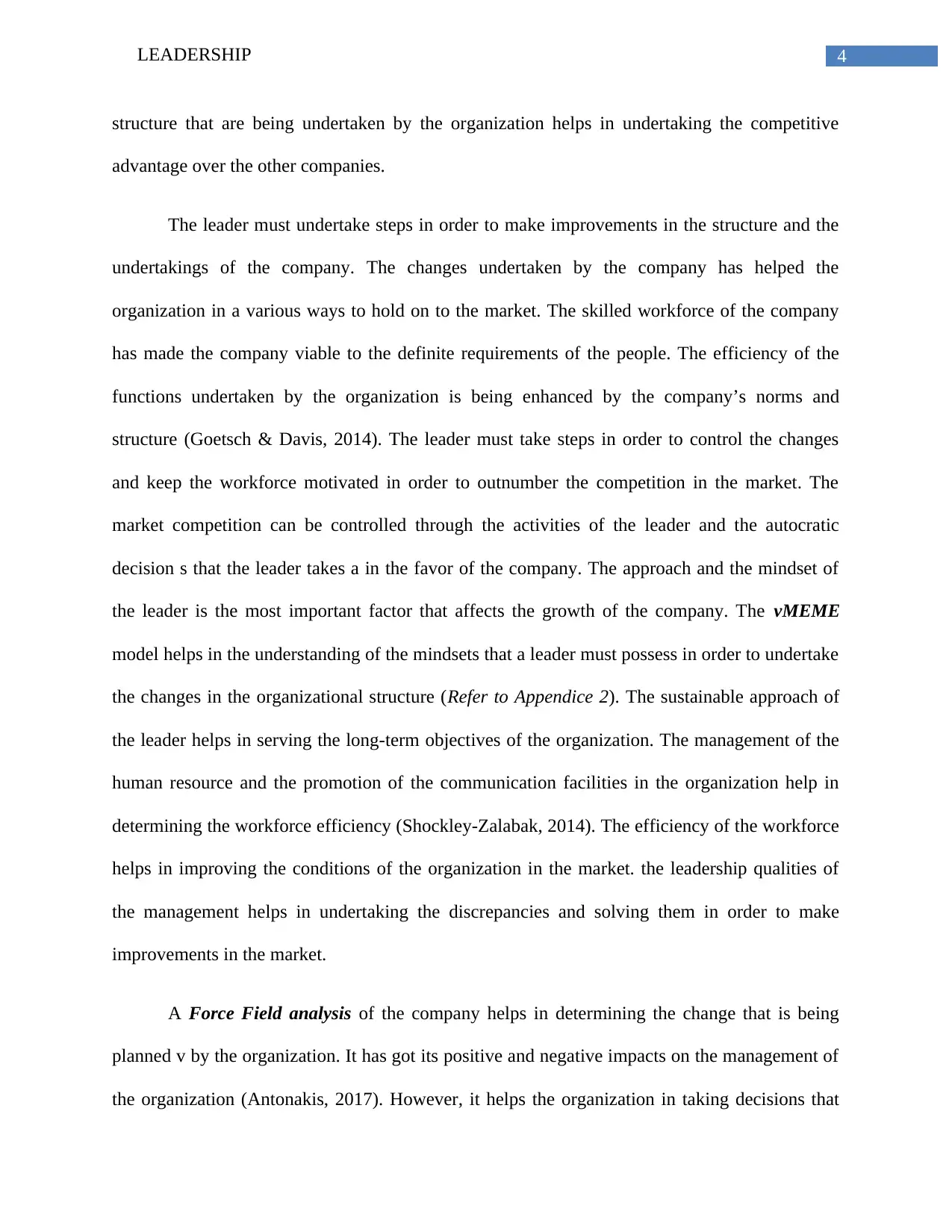
4LEADERSHIP
structure that are being undertaken by the organization helps in undertaking the competitive
advantage over the other companies.
The leader must undertake steps in order to make improvements in the structure and the
undertakings of the company. The changes undertaken by the company has helped the
organization in a various ways to hold on to the market. The skilled workforce of the company
has made the company viable to the definite requirements of the people. The efficiency of the
functions undertaken by the organization is being enhanced by the company’s norms and
structure (Goetsch & Davis, 2014). The leader must take steps in order to control the changes
and keep the workforce motivated in order to outnumber the competition in the market. The
market competition can be controlled through the activities of the leader and the autocratic
decision s that the leader takes a in the favor of the company. The approach and the mindset of
the leader is the most important factor that affects the growth of the company. The vMEME
model helps in the understanding of the mindsets that a leader must possess in order to undertake
the changes in the organizational structure (Refer to Appendice 2). The sustainable approach of
the leader helps in serving the long-term objectives of the organization. The management of the
human resource and the promotion of the communication facilities in the organization help in
determining the workforce efficiency (Shockley-Zalabak, 2014). The efficiency of the workforce
helps in improving the conditions of the organization in the market. the leadership qualities of
the management helps in undertaking the discrepancies and solving them in order to make
improvements in the market.
A Force Field analysis of the company helps in determining the change that is being
planned v by the organization. It has got its positive and negative impacts on the management of
the organization (Antonakis, 2017). However, it helps the organization in taking decisions that
structure that are being undertaken by the organization helps in undertaking the competitive
advantage over the other companies.
The leader must undertake steps in order to make improvements in the structure and the
undertakings of the company. The changes undertaken by the company has helped the
organization in a various ways to hold on to the market. The skilled workforce of the company
has made the company viable to the definite requirements of the people. The efficiency of the
functions undertaken by the organization is being enhanced by the company’s norms and
structure (Goetsch & Davis, 2014). The leader must take steps in order to control the changes
and keep the workforce motivated in order to outnumber the competition in the market. The
market competition can be controlled through the activities of the leader and the autocratic
decision s that the leader takes a in the favor of the company. The approach and the mindset of
the leader is the most important factor that affects the growth of the company. The vMEME
model helps in the understanding of the mindsets that a leader must possess in order to undertake
the changes in the organizational structure (Refer to Appendice 2). The sustainable approach of
the leader helps in serving the long-term objectives of the organization. The management of the
human resource and the promotion of the communication facilities in the organization help in
determining the workforce efficiency (Shockley-Zalabak, 2014). The efficiency of the workforce
helps in improving the conditions of the organization in the market. the leadership qualities of
the management helps in undertaking the discrepancies and solving them in order to make
improvements in the market.
A Force Field analysis of the company helps in determining the change that is being
planned v by the organization. It has got its positive and negative impacts on the management of
the organization (Antonakis, 2017). However, it helps the organization in taking decisions that

5LEADERSHIP
might help in the process of undertaking the change. The concerned company is looking for the
change and the constraints to the change are being undertaken by the organization (Refer to
Appendice 3). The analysis helps in determining the requirements of the consumers to which the
organization must adhere. Moreover, it determines the requirement of the organization to
increase the production based on the demand of the consumers (Robbins & Judge, 2012). On the
other hand, it describes the important constraints to the change that is being planned by the
organization. It helps in determining the cost of production and the other expenses that the
company must undertake in order to make the change profitable for the business. It is more like a
Big Data, which gives a clear view of the situation of the company and the reason behind the
change that is undertaken.
Therefore, from the above discussion it can be stated that a leader takes the most
important steps in bringing about the change in the organizational structure. It helps in
determining the objectives of the company and thereby helps the company in achieving the
common goal. The changes that are required to be undertaken by the company are determined by
the situation of the organization in the market. In order to improve the situation of the company
steps are required to be taken by the leader. The changes help in undertaking the improvements
in the organization’s situation in the market.
.
might help in the process of undertaking the change. The concerned company is looking for the
change and the constraints to the change are being undertaken by the organization (Refer to
Appendice 3). The analysis helps in determining the requirements of the consumers to which the
organization must adhere. Moreover, it determines the requirement of the organization to
increase the production based on the demand of the consumers (Robbins & Judge, 2012). On the
other hand, it describes the important constraints to the change that is being planned by the
organization. It helps in determining the cost of production and the other expenses that the
company must undertake in order to make the change profitable for the business. It is more like a
Big Data, which gives a clear view of the situation of the company and the reason behind the
change that is undertaken.
Therefore, from the above discussion it can be stated that a leader takes the most
important steps in bringing about the change in the organizational structure. It helps in
determining the objectives of the company and thereby helps the company in achieving the
common goal. The changes that are required to be undertaken by the company are determined by
the situation of the organization in the market. In order to improve the situation of the company
steps are required to be taken by the leader. The changes help in undertaking the improvements
in the organization’s situation in the market.
.
⊘ This is a preview!⊘
Do you want full access?
Subscribe today to unlock all pages.

Trusted by 1+ million students worldwide
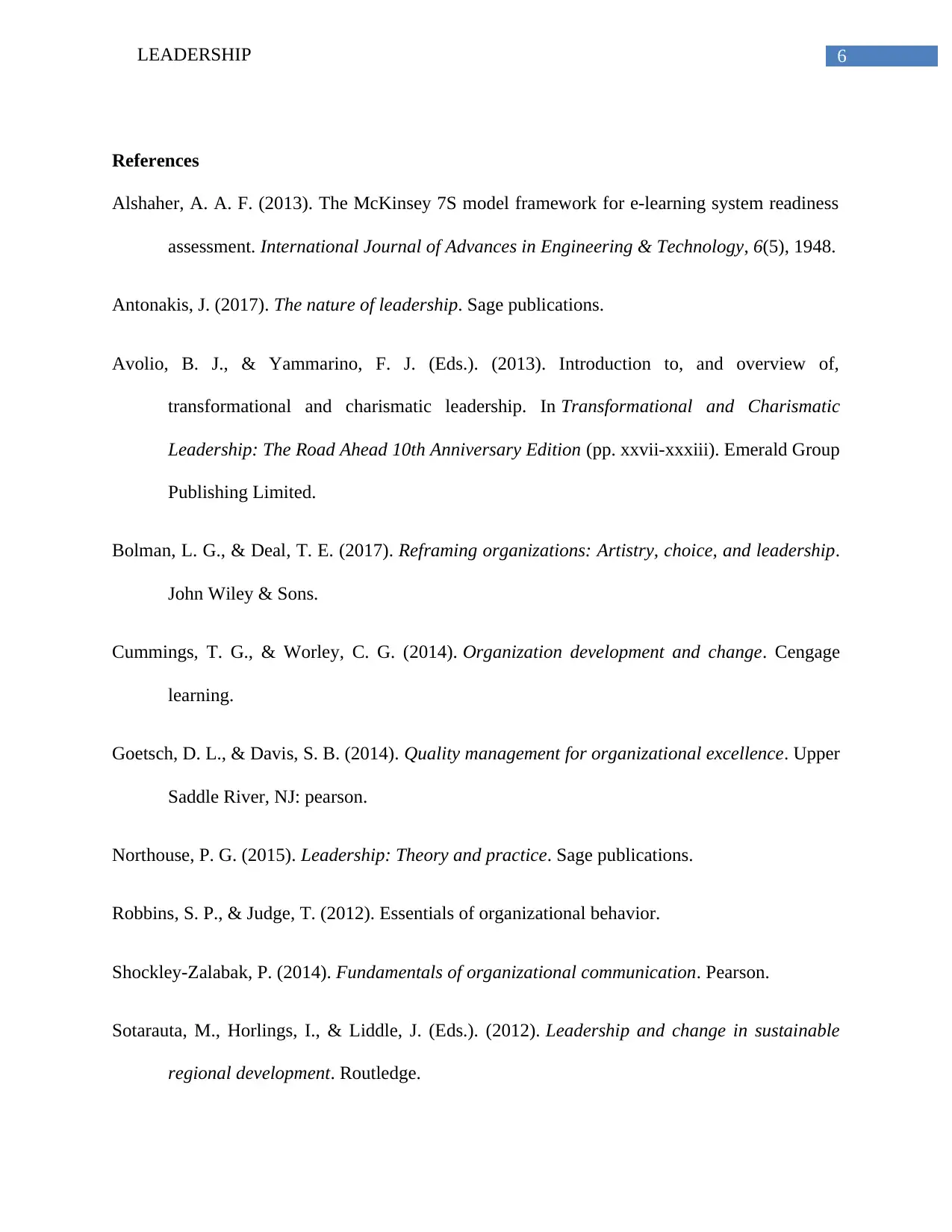
6LEADERSHIP
References
Alshaher, A. A. F. (2013). The McKinsey 7S model framework for e-learning system readiness
assessment. International Journal of Advances in Engineering & Technology, 6(5), 1948.
Antonakis, J. (2017). The nature of leadership. Sage publications.
Avolio, B. J., & Yammarino, F. J. (Eds.). (2013). Introduction to, and overview of,
transformational and charismatic leadership. In Transformational and Charismatic
Leadership: The Road Ahead 10th Anniversary Edition (pp. xxvii-xxxiii). Emerald Group
Publishing Limited.
Bolman, L. G., & Deal, T. E. (2017). Reframing organizations: Artistry, choice, and leadership.
John Wiley & Sons.
Cummings, T. G., & Worley, C. G. (2014). Organization development and change. Cengage
learning.
Goetsch, D. L., & Davis, S. B. (2014). Quality management for organizational excellence. Upper
Saddle River, NJ: pearson.
Northouse, P. G. (2015). Leadership: Theory and practice. Sage publications.
Robbins, S. P., & Judge, T. (2012). Essentials of organizational behavior.
Shockley-Zalabak, P. (2014). Fundamentals of organizational communication. Pearson.
Sotarauta, M., Horlings, I., & Liddle, J. (Eds.). (2012). Leadership and change in sustainable
regional development. Routledge.
References
Alshaher, A. A. F. (2013). The McKinsey 7S model framework for e-learning system readiness
assessment. International Journal of Advances in Engineering & Technology, 6(5), 1948.
Antonakis, J. (2017). The nature of leadership. Sage publications.
Avolio, B. J., & Yammarino, F. J. (Eds.). (2013). Introduction to, and overview of,
transformational and charismatic leadership. In Transformational and Charismatic
Leadership: The Road Ahead 10th Anniversary Edition (pp. xxvii-xxxiii). Emerald Group
Publishing Limited.
Bolman, L. G., & Deal, T. E. (2017). Reframing organizations: Artistry, choice, and leadership.
John Wiley & Sons.
Cummings, T. G., & Worley, C. G. (2014). Organization development and change. Cengage
learning.
Goetsch, D. L., & Davis, S. B. (2014). Quality management for organizational excellence. Upper
Saddle River, NJ: pearson.
Northouse, P. G. (2015). Leadership: Theory and practice. Sage publications.
Robbins, S. P., & Judge, T. (2012). Essentials of organizational behavior.
Shockley-Zalabak, P. (2014). Fundamentals of organizational communication. Pearson.
Sotarauta, M., Horlings, I., & Liddle, J. (Eds.). (2012). Leadership and change in sustainable
regional development. Routledge.
Paraphrase This Document
Need a fresh take? Get an instant paraphrase of this document with our AI Paraphraser
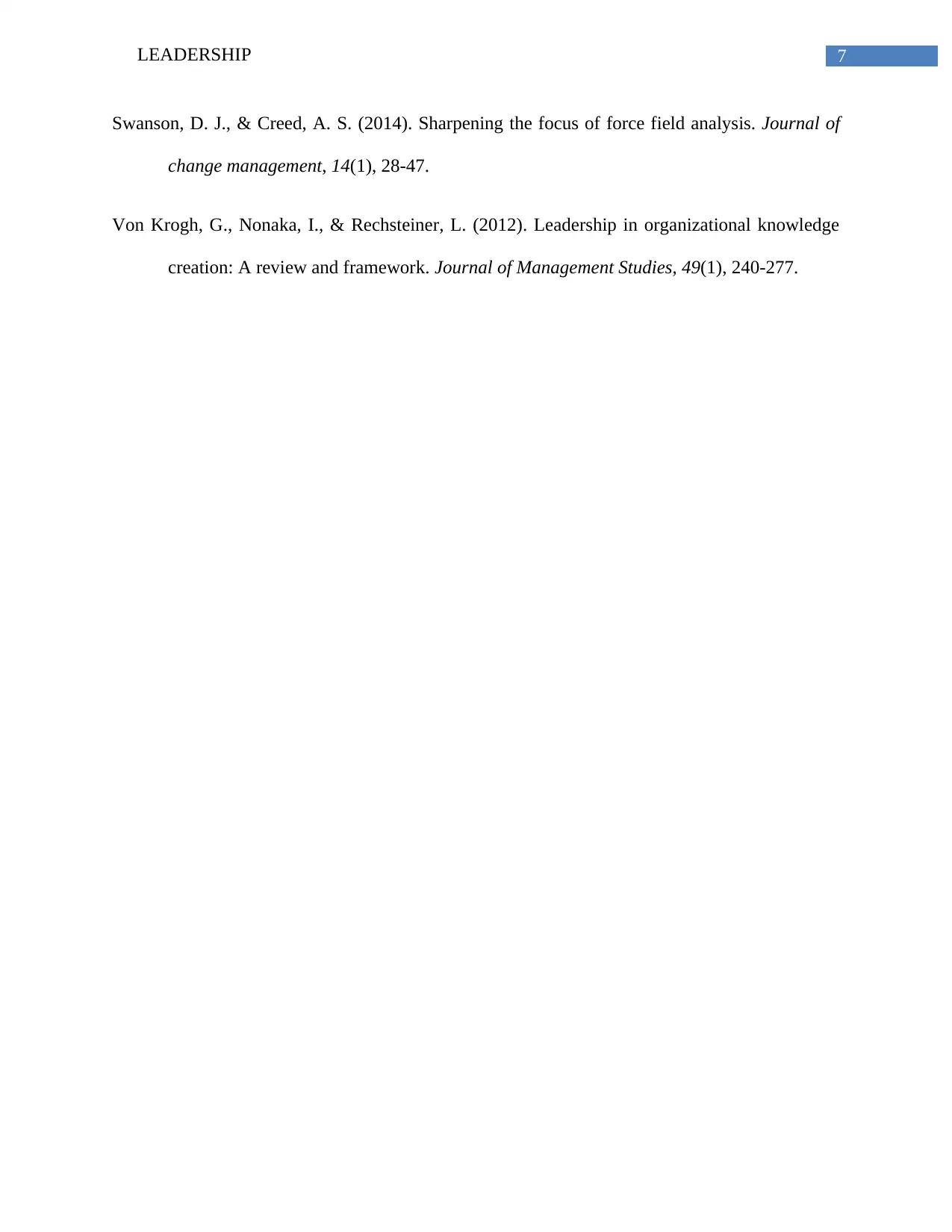
7LEADERSHIP
Swanson, D. J., & Creed, A. S. (2014). Sharpening the focus of force field analysis. Journal of
change management, 14(1), 28-47.
Von Krogh, G., Nonaka, I., & Rechsteiner, L. (2012). Leadership in organizational knowledge
creation: A review and framework. Journal of Management Studies, 49(1), 240-277.
Swanson, D. J., & Creed, A. S. (2014). Sharpening the focus of force field analysis. Journal of
change management, 14(1), 28-47.
Von Krogh, G., Nonaka, I., & Rechsteiner, L. (2012). Leadership in organizational knowledge
creation: A review and framework. Journal of Management Studies, 49(1), 240-277.
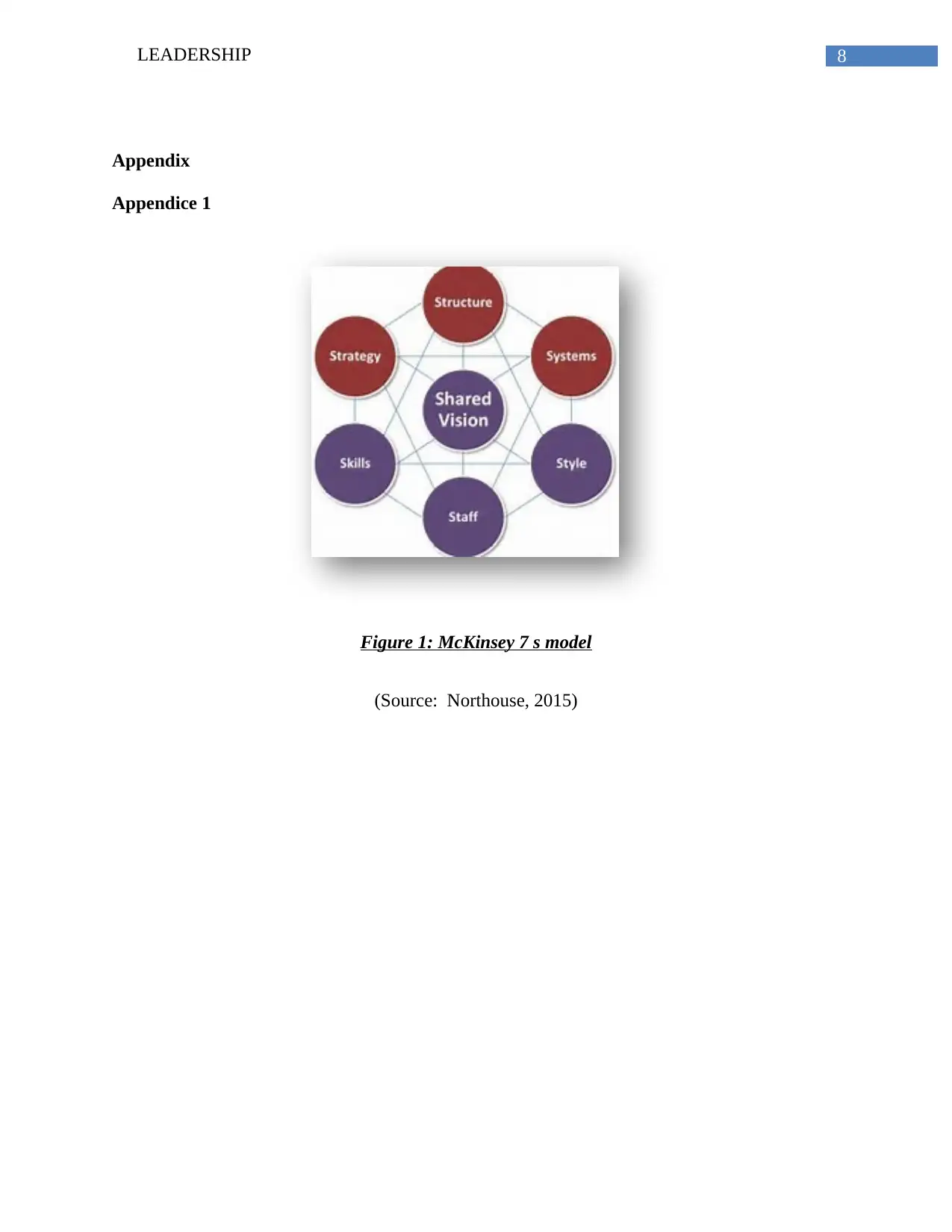
8LEADERSHIP
Appendix
Appendice 1
Figure 1: McKinsey 7 s model
(Source: Northouse, 2015)
Appendix
Appendice 1
Figure 1: McKinsey 7 s model
(Source: Northouse, 2015)
⊘ This is a preview!⊘
Do you want full access?
Subscribe today to unlock all pages.

Trusted by 1+ million students worldwide

9LEADERSHIP
Appendice 2
Figure 2: vMEME
(Source: Alshaher, 2013 )
Appendice 2
Figure 2: vMEME
(Source: Alshaher, 2013 )
Paraphrase This Document
Need a fresh take? Get an instant paraphrase of this document with our AI Paraphraser

10LEADERSHIP
Appendice 3
Figure 3: Force field Analysis
(Source: Robbins & Judge, 2012)
Appendice 3
Figure 3: Force field Analysis
(Source: Robbins & Judge, 2012)
1 out of 11
Related Documents
Your All-in-One AI-Powered Toolkit for Academic Success.
+13062052269
info@desklib.com
Available 24*7 on WhatsApp / Email
![[object Object]](/_next/static/media/star-bottom.7253800d.svg)
Unlock your academic potential
Copyright © 2020–2025 A2Z Services. All Rights Reserved. Developed and managed by ZUCOL.





